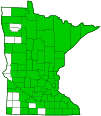red elderberry
(Sambucus racemosa var. racemosa)
Conservation • Wetland • Description • Habitat • Ecology • Use • Distribution • Taxonomy
Description |
Red elderberry, also called red-berried elder, is a fast growing shrub rising on multiple stems from shallow roots and rhizomes. The stems are erect or arching, branching, hairless, up to 13′ tall, and up to 4¾″ in diameter at breast height. They are dotted with conspicuous, large, raised, warty bumps (lenticels). The bark on first year stems is gray and smooth. Bark on older stems is gray to reddish-brown and rough with thin, narrow, plate-like scales. The twigs are stout. The area of cells in the center of the stem (pith) is large, encompassing more than half of the diameter of the twig. First-year twigs greenish-brown and covered with short, soft hairs. Second-year twigs are grayish to brownish and hairless. The pith is white in first-year twigs, tan or orangish-brown in second-year twigs. There are no terminal buds. The leaves are opposite, deciduous, and pinnately divided into usually 5, occasionally 7, leaflets. They are attached to the twig on a 1¼″ to 2¾″ long leaf stalk. The leaf stalk is hairy on all surfaces. The leaflets are lance-shaped to egg-shaped or elliptic, 2″ to 4¾″ long, and ¾″ to 2″ wide. They are attached to the central leaf stalk (rachis) on ⅛″ to ⅝″ long stalks. They are rounded or tapered and asymmetrical at the base and taper to a point at the tip with concave sides along the tip. The terminal leaflet is often somewhat smaller than the lateral leaflets. The upper surface of the leaflet is dark green, and sparsely hairy, at least along the midvein. The lower surface is pale green and hairy along the veins. The margins have fine, sharp, forward-pointing teeth. The inflorescence is a branched, 1¼″ to 3⅛″ wide cluster (cyme) at the ends of the stems and branches. The cymes are pyramid-shaped or egg-shaped. They rise on erect, ¾″ to 3½″ long stalks. Each cyme has 100 to 200 small flowers. The flowers are ⅛″ to ¼″ wide. There are 5 yellowish-white petals and 5 stamens with white filaments and yellow anthers. They appear in late April to early June. The fruit is a juicy, globular berry, ⅛″ to ¼″ in diameter, containing 3 to 5 seeds. It ripens in mid-June to late July, turning bright red. |
Height |
5′ to 13′ |
Flower Color |
Yellowish-white |
Similar Species |
Nannyberry (Viburnum lentago) has undivided (simple), hairless leaves. The inflorescence is dome-shaped. American elderberry (Sambucus nigra var. canadensis) second year twigs have white pith. The leaves usually have 7 leaflets, occasionally 5 or 9. The leaf stalk upper surface channel is hairy but the leaf stalk is otherwise hairless. The leaflets are symmetrical at the base and are less coarsely toothed. The inflorescence is larger and flat-topped. It blooms from early July to mid-August. Mature berries are dark, blackish-purple. |
Habitat |
Moist to moderate moisture. Deciduous, coniferous, and mixed forests, swamps, marsh edges, stream banks, lake shores. Full sun to full shade. |
Ecology |
Flowering |
Late April to early June |
Pests and Diseases |
|
Toxicity |
The fruit is safe to eat when cooked. The raw fruit, the seeds, and all other parts of the plant are poisonous, and can be lethal at high doses. |
Use |
|
Distribution |
||
|
Sources |
|
| 4/28/2025 | ||
Nativity |
||
Native |
||
Occurrence |
||
Common |
||
Taxonomy |
|
Kingdom |
|
Division |
Tracheophyta (Vascular Plants) |
Subdivision |
Spermatophytina (Seed Plants) |
Class |
|
Order |
Dipsacales (honeysuckles, moschatels, and allies) |
Family |
Viburnaceae (elder) |
Genus |
Sambucus (elders) |
Species |
Sambucus racemosa (red-berried elder) |
Species Family Currently (2023), some sources, including USDA PLANTS and NatureServe, place the genera Sambucus and Viburnum in the Caprifoliaceae family. Some sources, including ITIS and NCBI, place them in the Adoxacea family. Almost all other sources, including APG IV, World Flora Online, Plants of the World Online, GRIN, GBIF, and iNaturalist, place the two genera in the Viburnaceae family. |
|
Subordinate Taxa |
|
|
|
Synonyms |
|
|
|
Common Names |
|
bunchberry elderberry red elderberry red-berried elder |
|
Glossary
Cyme
A branched, flat-topped or convex flower cluster in which the terminal flower opens first and the outermost flowers open last.
Lenticel
A corky, round or stripe-like, usually raised, pore-like opening in bark that allows for gas exchange.
Pinnate
On a compound leaf, having the leaflets arranged on opposite sides of a common stalk. On a bryophyte, having branches evenly arranged on opposite sides of a stem.
Pith
The spongy cells in the center of the stem.
Rachis
The main axis of a compound leaf, appearing as an extension of the leaf stalk; the main axis of an inflorescence.
Rhizome
A horizontal, usually underground stem. It serves as a reproductive structure, producing roots below and shoots above at the nodes.
Visitor Photos |
||
Share your photo of this plant. |
||
This button not working for you? |
||
Luciearl |
||
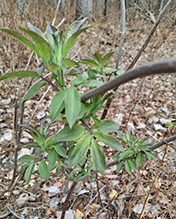 |
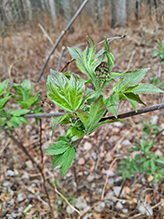 |
|
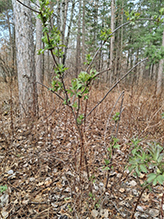 |
||
Cindy C |
||
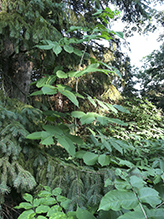 |
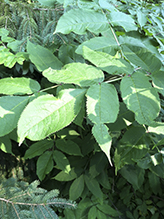 |
|
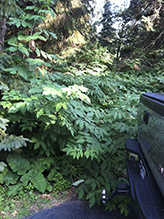 |
||
MinnesotaSeasons.com Photos |
||
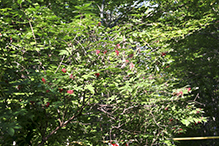 |
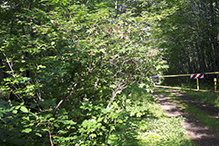 |
|
Plant |
Plant |
|
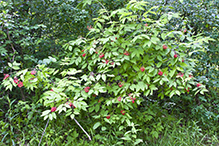 |
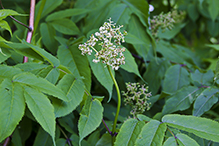 |
|
Plant |
Inflorescence |
|
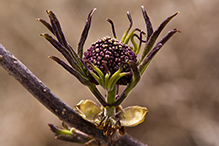 |
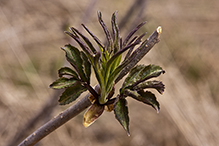 |
|
Inflorescence in early spring |
Inflorescence in early spring |
|
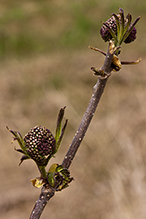 |
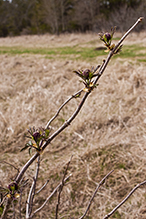 |
|
Inflorescence in early spring |
|
|
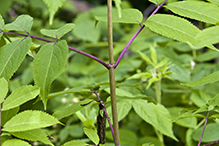 |
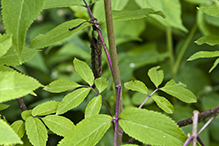 |
|
Twig |
Twig |
|
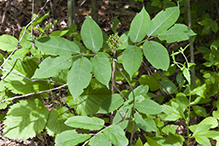 |
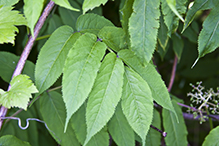 |
|
Leaves with 5 leaflets |
Leaves with 7 leaflets |
|
 |
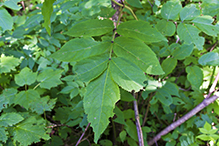 |
|
Leaves with 7 leaflets |
Leaves with 7 leaflets |
|
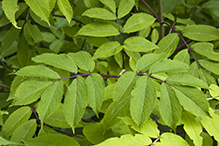 |
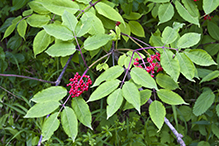 |
|
Leaves with 7 leaflets |
Infructescence |
|
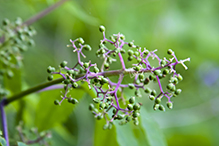 |
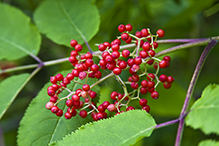 |
|
Infructescence |
Infructescence |
|
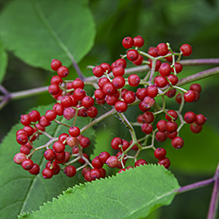 |
||
Infructescence |
|

Slideshows |
Sambucus racemosa |
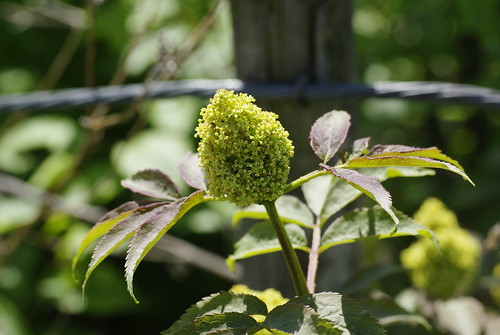
|
About
Rødhyll, red elderberry |
Red-berried Elder (Sambuscus racemosa) |
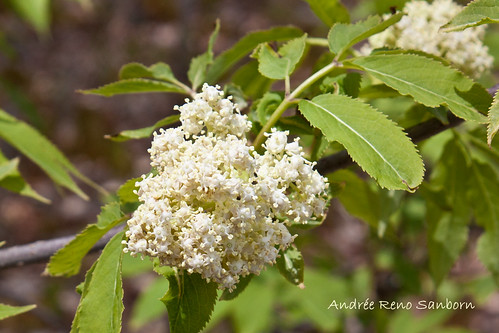
|

Visitor Videos |
||
Share your video of this plant. |
||
This button not working for you? |
||
|
Other Videos |
||
Red Elderberry - Wild Edible Plant Series |
About
Published on Feb 27, 2014 http://alexansary.tv/wild-edible-medicinal-plants-pacific-northwest/ In our world, having the knowledge of what wild edible plants in your area are safe to forage for either medicinal, edible or use is very valuable. Whether your motivation is preparedness, getting closer to nature, health and wellness, or botany, there is something for you in this video series. John Gallagher talks you on a walking tour of wild edible and medicinal plants of the pacific northwest. This video series was filmed and edited by Alex Ansary in 2008 and shot in Duvall, Washington. John is a instructor at the Wilderness Awareness School. More videos from this school and on the topic of edible plants are coming to this channel. Please subscribe today. John's website is: http://www.LearningHerbs.Com. |
Red Elderberry |
About
Uploaded on Jul 12, 2011 Red Elderberry, very pretty and not at all edible. |
sambucus racemosa |
About
Published on Jun 22, 2014 No description available. |

Visitor Sightings |
||
Report a sighting of this plant. |
||
This button not working for you? |
||
Luciearl |
Location: Lake Shore, MN |
 |
| Cindy C 8/2/2014 |
Location: Zimmerman, MN (Sherburne County) |
 |
MinnesotaSeasons.com Sightings |
||
Bertram Chain of Lakes Regional Park Carpenter St. Croix Valley Nature Center Charles A. Lindbergh State Park Clifton E. French Regional Park Itasca Wilderness Sanctuary SNA Minnesota Valley State Recreation Area, Lawrence Unit Nerstrand Big Woods State Park Robert Ney Memorial Park Reserve Spring Beauty Northern Hardwoods SNA Stanley Eddy Memorial Park Reserve |

|
Created: 11/24/2009 Last Updated: © MinnesotaSeasons.com. All rights reserved. |
